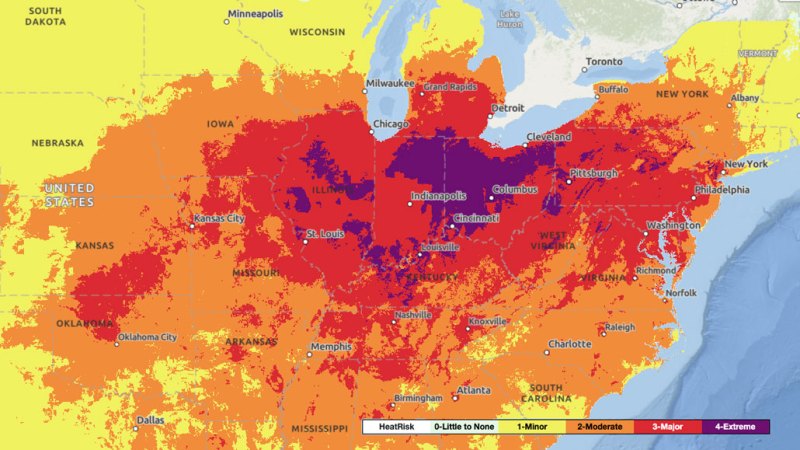Extreme Climate Survey
Scientific news is collecting questions from readers about how to navigate our planet’s changing climate.
What do you want to know about extreme heat and how it can lead to extreme weather events?
It’s early for this kind of heat, though perhaps not unprecedented, says Benjamin Zaitchik, a climate scientist at Johns Hopkins University. We were seeing temperatures that have been more typical for late July, early August. We were seeing them this year in June, which is unusual. Weather can do that. With increasing frequency and intensity of heat waves around the globe, this is part of the pattern of climate change.
Such early heat waves can be more dangerous than those that occur later in the summer, Zaitchik says. This is partly because our bodies have adapted to the late summer heat, a bit like acclimating to a hot bath. Such sudden hot temperatures can catch people by surprise. Outdoor activities that would normally be perfect for June weather in mild places can become dangerous.
Moreover, across entire regions, overnight temperatures are not dropping enough to provide relief. Those regions glow purple in a new online tool called HeatRisk, developed by U.S. public health and climate experts to track dangerous heat for up to a week (SN: 22.4.24).

As temperatures across the country warm, here’s what you need to know about heat and health.
Extreme heat is hard on our bodies
The heat can be deadly. In the United States, heat causes more deaths than any other natural disaster, including floods, tornadoes and hurricanes.
Our bodies usually have ways to handle heat. As blood circulates just below the surface of the skin, it gives off heat. Evaporation of sweat helps to cool our skin. But these methods only work up to a certain point (SN: 27/7/22). And as temperatures and humidity rise more and more during heat waves, weakening our ability to cool by evaporation or evaporation, we become more vulnerable to unrelenting heat.
Some body systems are stressed under prolonged hot temperatures (SN: 8/6/23). Pushing blood to the skin in an attempt to cool the body can deprive vital organs such as the heart and lungs of oxygen. Excessive sweating increases the risk of dehydration, putting extra pressure on the heart to pump blood thick from lack of water. The kidneys, which need water to regulate fluid levels and filter toxins from the blood, also suffer.
Body temperatures that rise too high can lead to weakness, headaches and dizziness, hallmarks of heat exhaustion. Heat exhaustion can progress to heat stroke if the body is not cooled, causing overheated and oxygen-deprived organs to fail. People with heatstroke can become delirious or have seizures, suffer permanent organ damage or even die.
Some people are at higher risk
Staying hydrated, limiting activity, and camping in air-conditioned buildings can help people (and their pets) stay safe during heat waves.
But for some, following this guideline is easier said than done. Homeless people or workers whose jobs require them to be outside in high heat may not have the opportunity to stay in cool environments. Those who live in urban areas with few trees or in humid climates may also be at higher risk than people who live in other, naturally cooler locations (SN: 4/3/18).
Others may have health conditions that make staying cool more important because these conditions put individuals at higher risk for heat-related symptoms. For example, extreme temperatures can cause increased stress on the hearts of pregnant people, which are already under tremendous pressure to pump more blood to two bodies. Heat exposure has been linked to premature births and low birth weight, according to the US Centers for Disease Control and Prevention.
Adults over 65 are also at higher risk, in part because older people can’t cool their bodies as efficiently as they could when they were younger. Individuals in this age group are also more likely to have chronic diseases such as diabetes or heart problems that heat can make worse. Older people with coronary artery disease who were exposed to rising temperatures had reduced blood flow to the heart compared with age-matched people without the disease, researchers report June 11 in. Annals of internal medicine.
Research suggests that by 2050, nearly a quarter of the global population of people aged 69 and over could experience temperature extremes beyond 37.5 Celsius.SN: 14.5.24).
The heat is also dangerous for young people with chronic diseases. Hot weather can cause increased air pollution, triggering asthma attacks. And some medications like metformin for diabetes can cause dehydration; Antipsychotic drugs for conditions such as schizophrenia can blunt the sweat response.
Communities must adapt as the late summer heat hits earlier
Finding ways to beat the heat isn’t easy.
As everything gets warmer under climate change, scientists have seen a shift toward warmer temperatures occurring earlier. Changing atmospheric circulation and climate feedback loops could lead to more extreme days hitting, which could mean more heat waves, Zaitchik says (SN: 11/9/23). This is potentially leading to extremes that are intensifying at a rate that is even faster or even more intense than seen on average.
With more hot days than in the past, researchers are looking at ways to protect the most vulnerable. Checking high-risk people who are mostly alone to make sure they are in a cool space or have water can save lives. Cities can ensure that bus stops are out of direct sunlight or that buses run on time and scheduled so that people taking public transport don’t have to wait half an hour in the heat.
But it’s important to work with communities to make sure people are getting what they want as well as what they need, Zaitchik says. For example, air conditioners can only help if people can afford to pay the electricity bill. We have to move quickly, but also strongly and together so that we don’t have false starts. We don’t have much time to fail and try again.
#heat #dome #roasting #United #States #Heres #dangerous
Image Source : www.sciencenews.org

